

When a problem occurs with DFI system, the warning indicator light (LED) [A] and FI warning symbol [B] goes on to alert the rider. In addition, the condition of the problem is stored in the memory of the ECU. For models equipped with an immobilizer system, the warning indicator light (LED) and immobilizer warning symbol [C] blinks, when a problem occurs in the system.
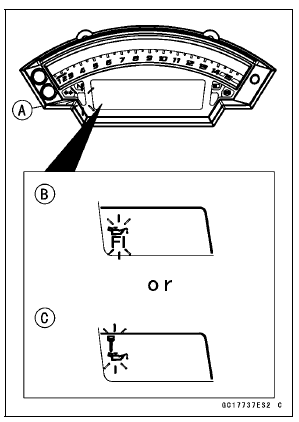
With the engine stopped and turned in the self-diagnosis mode, the service code [A] is displayed on the LCD (Liquid Crystal Display) by the number of two digits (see Self -Diagnosis Procedures in the Self-Diagnosis System chapter).
If the problem is with the following parts, the ECU can not recognize these problem. Therefore, the warning indicator light (LED), FI and/or immobilizer warning symbols do not goes on and/or blinks, and service code is not displayed.
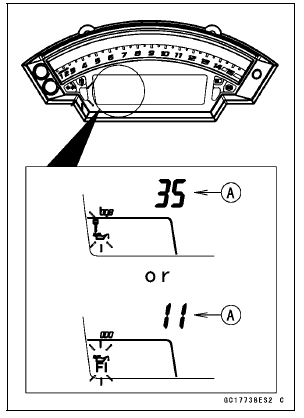
LCD for Meter Unit
Fuel Pump
Primary and Secondary Fuel Injectors
Stick Coil Secondary Wiring and Ground Wiring
ECU Power Source Wiring and Ground Wiring
When the service code [A] is displayed, for first ask the rider about the conditions [B] of trouble, and then start to determine the cause [C] of problem.
As a pre-diagnosis inspection, check the ECU for ground and power supply, the fuel line for no fuel leaks, and for correct pressure. The pre-diagnosis items are not indicated by the warning indicator light (LED) and FI warning symbol.
Don’t rely solely on the DFI self-diagnosis function, use common sense.
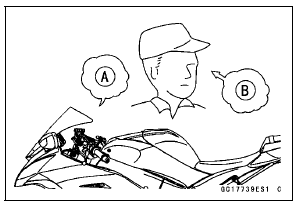
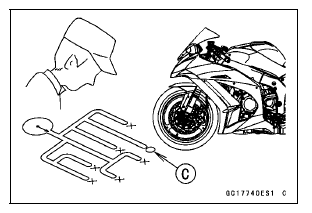
Even when the DFI system is operating normally, the warning indicator light (LED) and FI warning symbol may goes on under strong electrical interference. Additional measures are not required. Turn the ignition switch to OFF to stop the indicator light and symbol.
If the warning indicator light (LED) and FI warning symbol of the motorcycle brought in for repair still goes on, check the service code.
When the repair has been done, the warning indicator light (LED) and FI warning symbol goes off. But the service codes stored in memory of the ECU are not erased to preserve the problem history. The problem history can be referred using the KDS (Kawasaki Diagnostic System) when solving unstable problems.
When the motorcycle is down, the vehicle-down sensor operates and the ECU shuts off the fuel pump relay, fuel injectors (primary and secondary) and ignition system. The ignition switch is left ON. If the starter button is pushed, the electric starter turns but the engine does not start. When the starter button is pushed, the warning indicator light (LED) and FI warning symbol blink but the service code is not displayed. To start the engine again, raise the motorcycle, turn the ignition switch to OFF, and then ON.
Much of the DFI system troubleshooting work consists of confirming continuity of the wiring. The DFI parts are assembled and adjusted with precision, and it is impossible to disassemble or repair them.
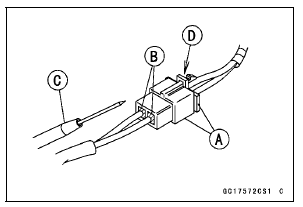
Special Tool - Needle Adapter Set: 57001-1457
NOTICE
Insert the needle adapter straight along the terminal in the connector to prevent short-circuit between terminals.
NOTICE
Incorrect, reverse connection or short circuit by needle adapters could damage the DFI or electrical system parts.
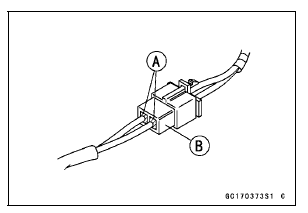
Sealant - Liquid Gasket, TB1211: 56019-120
Never replace a defective part without determining what CAUSED the problem. If the problem was caused by some other item or items, they too must be repaired or replaced, or the new replacement part will soon fail again.
If any wiring is deteriorated, replace the wiring.
If the connector is corroded or dirty, clean it carefully. If it is damaged, replace it. Connect the connectors securely.
Use the wiring diagram to find the ends of the lead which is suspected of being a problem.
Connect the hand tester between the ends of the leads.
Special Tool - Hand Tester: 57001-1394
If the tester does not read 0 Ω, the lead is defective. Replace the lead or the main harness.
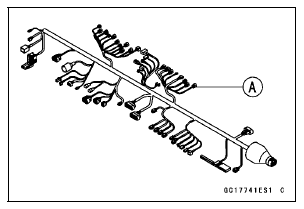
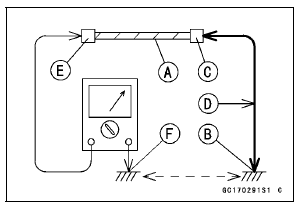
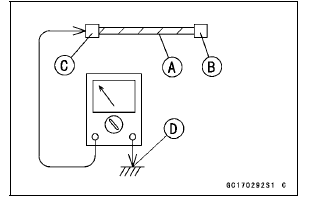
If no abnormality is found in the wiring or connectors, the DFI parts are the next likely suspects. Check the part, starting with input and output voltages. However, there is no way to check the ECU itself.
If an abnormality is found, replace the affected DFI part.
If no abnormality is found in the wiring, connectors, and DFI parts, replace the ECU.
 Troubleshooting the DFI System
Troubleshooting the DFI System Inquiries to Rider
Inquiries to RiderCheck 3-3: High Beam Indicator Light (LED) Inspection
Connect the leads in the same circuit as Check 3-2.
Connect the terminal [7] to the battery (+) terminal.
Check that the high beam indicator light (LED) [A] goes
on.
If the indicator light does not go on, replace the meter unit.
...
Service Code Erasing
When repair has been done, warning indicator light (LED) and warning symbol
go off and service
code are not displayed.
But the service codes stored in memory of the ECU are not erased to preserve
the problem history.
In this model, the problem history can not be erased. However, the memorie ...
Exploded View
7. US, CA and CAL Models
8. Immobilizer System Equipped Models
9. ZX1000JD/KD
AD: Apply adhesive.
L: Apply a non-permanent locking agent.
R: Replacement Parts
13. Other than US, CA and CAL Models
CL: Apply cable lubricant.
EO: Apply engine oil.
G: Apply grease.
L: Apply a ...